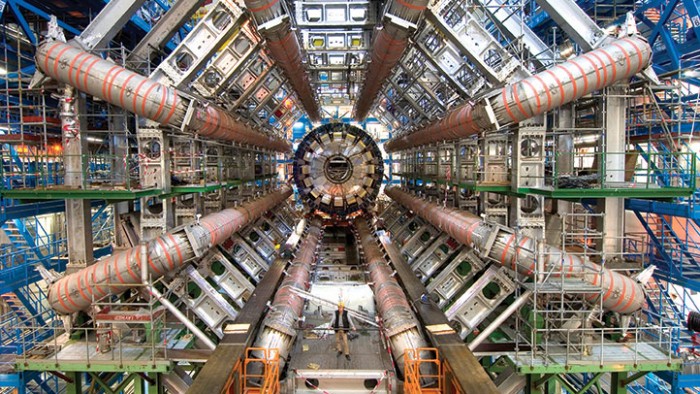 Natural Sciences
Natural Sciences
Collision Course

Searching for subatomic particles using an atom-smashing collider is a bit like panning for gold in a stream. It takes a lot of effort to find the tiniest glitter.
UO physics students are doing something about that. In the lab of Stephanie Majewski (right), an assistant professor of physics, undergraduates are working on new tools to help researchers at the Large Hadron Collider (LHC) in Geneva—the massive underground collider that recently wowed the science world by detecting the elusive Higgs boson particle.
At any given time, Majewski has three or four undergraduates working on research projects in particle physics—specifically, in support of her work on the LHC. Her undergraduates are tasked with coming up with new algorithms—formulas that can be programmed into a computer chip to solve mathematical problems.
Researchers use these formulas to identify which of the trillions of “interactions” that happen in a proton collision are actually the rare result of something new and interesting, and which ones are just so much humdrum atomic activity.
The collider produces vastly more uninteresting results than it does intriguing ones, so it’s helpful to sift as quickly as possible through the mathematical data describing those collisions. The best work of Majewski’s undergraduates stands a good chance of being incorporated into a coming upgrade of the ATLAS detector (above), one of the primary observing
stations at the LHC that records the tiny bits of subatomic debris thrown out by particle collisions.
“These students are doing real physics projects,” Majewski said. “These are extremely important studies we need in order to upgrade the detector.”
 Majewski (right) is always on the lookout for physics majors with solid programming skills to help the UO’s strong ATLAS team, which numbers more than 20 faculty members, postdoctoral researchers, and graduate and undergraduate students. It’s an opportunity for undergraduates to get in on the ground floor of a major research project and experience life as a scientist.
Majewski (right) is always on the lookout for physics majors with solid programming skills to help the UO’s strong ATLAS team, which numbers more than 20 faculty members, postdoctoral researchers, and graduate and undergraduate students. It’s an opportunity for undergraduates to get in on the ground floor of a major research project and experience life as a scientist.
Research like this also provides students with skills in high demand in the working world. The fields of health care, insurance, medical research, finance, and others are snapping up graduates who can design algorithms that help them sort through vast troves of data to find the connections and correlations that lead to new or improved products or services.
“These sorts of skills are just extremely valuable,” Majewski said. “There are not enough people with programming skills who can also think and attack problems.”
The work also helps undergraduates determine if graduate school should be part of their career path, she added.
But number-crunching isn’t the only thing that undergrads bring to the lab. Like the particles spinning around the LHC, younger students boost the energy level of Majewski’s team—this enthusiasm can’t help but rub off on older researchers.
Having undergraduates in the lab “gives everyone a boost,” Majewski said. “We get to see things through their eyes, like it’s the first time all over again.”
—Greg Bolt


 Twitter
Twitter Facebook
Facebook Forward
Forward